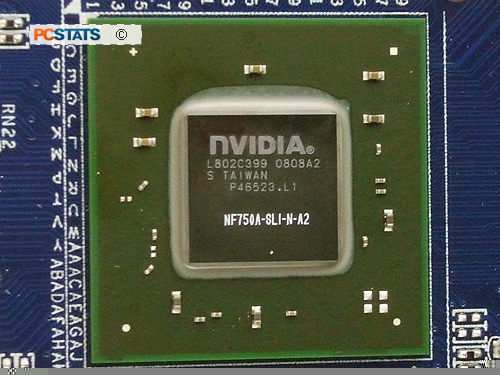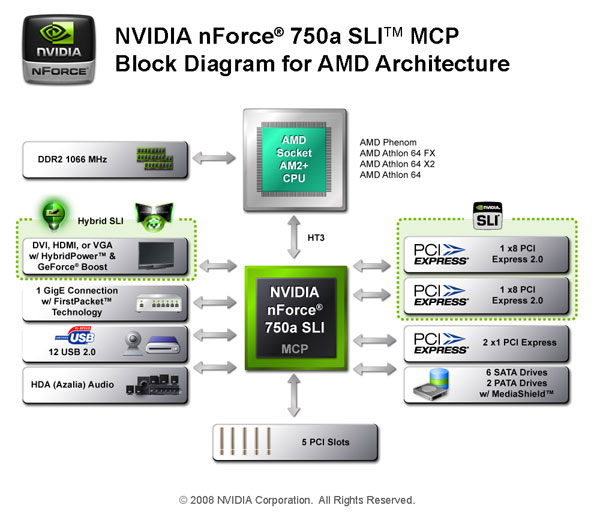 The nVidia nForce 750a SLI chipset is a bit of a curiosity... At its heart
beats an IGP, the NVIDA 8200 graphics processor, which is powerful enough that NVIDIA
refers to it as an mGPU. This NVIDIA 8200 mGPU is essentially a repackaged and
re-purposed Geforce 8400GS graphics card, so it has 16 1.2GHz stream processors and a 500MHz core clock speed.
The nVidia nForce 750a SLI chipset is a bit of a curiosity... At its heart
beats an IGP, the NVIDA 8200 graphics processor, which is powerful enough that NVIDIA
refers to it as an mGPU. This NVIDIA 8200 mGPU is essentially a repackaged and
re-purposed Geforce 8400GS graphics card, so it has 16 1.2GHz stream processors and a 500MHz core clock speed.
In addition to the (limited) 3D
gaming capabilities of an IGP, the NVIDIA 8200 mGPU also harnesses NVIDIA's Purevideo HD
video decoding capabilities. This latest revision of Purevideo supports 100% hardware decoding of H.264, VC-1 and MPEG-2
codecs - basically what your standard HD movie or Blu-Ray disk relies upon.
To further enhance
the NVIDIA 8200 mGPU's allure for HTPC builders, the nForce 750a SLI also supports HDMI
1.3a playback with support for 48-bit colour, the ability to display resolutions beyond
1080p as well as Dolby Digital Plus, Dolby True HD and DTS-HS audio.
In
contrast to its integrated video capabilities, the nForce 750a SLI can also
function in SLI mode. A single PCI Express videocard will receive 16 lanes bandwidth, dual Geforce
graphics cards in SLI will each receive 8 lanes of bandwidth. It's sufficient for most
videocards, but owners of exotic NVIDIA Geforce GTX 280s might want
to consider the nForce 780a SLI chipet's three x16's PCI Express lanes of
bandwidth instead.

The
Hybrid SLI capabilities of the
NVIDIA 8200 mGPU permit and a single Geforce 8400 GS or 8500 GT to be linked with
it Hybrid SLI mode, which pairs the IGP with a discrete GPU in order to boost the
overall 3D graphics power for games. While this does provide some
performance enhancement on its own, it's not powerful eough to play serious 3D games with, and will
cost significantly more and perform significantly worse than buying a separate
discrete graphics card like a Geforce 9800GT and a basic motherboard without
onboard graphics.
The saving grace is Hybrid Power mode,
which can disable power to a discrete graphics card and instead use the NVIDIA
8200 mGPU to handle simple 2D rendering tasks. While most videocards do ramp
down their power draw when not under load, being able to shut off the card
completely along with the power it consumes is still more efficient.
Okay, now for some really interesting power consumption
numbers!
Motherboard Power Draw Comparisons
Here's
how the Biostar
TPower N750 motherboard stacks up in real life against a couple different
motherboards. We have no way of directly measuring motherboard power draw, so
PCSTATS measures total system power draw and compares that in CPU-loaded (max
value recorded in Prime95) and idle states (at Windows Vista desktop). An Extech
380803 AC Power Analyzer and A-PFC compliant PC Power and
Cooling 750W power supply were used for
these tests.
 System Power Draw Tests: (PCPower 750W
PSU) System Power Draw Tests: (PCPower 750W
PSU) |
| Desktop Idle (W) |
Watts |
Ranking |
| Intel DG45ID (Intel G45 200/800 C2D
E6750 Onboard G45 ) |
68 |
   |
| Foxconn A7DA-S (AMD 790GX 200/800 AM2
X2 5000+ GF 8800GTS 320MB) |
131 |
   |
| Foxconn A7DA-S (AMD 790GX 200/800 AM2
X2 5000+ onboard HD 3300 video) |
61 |
   |
 Biostar TPower N750 (NF 750a SLI 200/800 AM2 X2 5000+ GF
8800GTS 320MB) Biostar TPower N750 (NF 750a SLI 200/800 AM2 X2 5000+ GF
8800GTS 320MB) |
110 |
   |
 Biostar TPower N750 (NF 750a SLI 200/800 AM2 X2 5000+
onboard nF 750a video) Biostar TPower N750 (NF 750a SLI 200/800 AM2 X2 5000+
onboard nF 750a video) |
45.4 |
   |
| Prime95 Stressed (W) |
Watts |
Ranking |
| Intel DG45ID (Intel G45 200/800 C2D
E6750 Onboard G45 ) |
121 |
   |
| Foxconn A7DA-S (AMD 790GX 200/800 AM2
X2 5000+ GF 8800GTS 320MB) |
192 |
   |
| Foxconn A7DA-S (AMD 790GX 200/800 AM2
X2 5000+ onboard HD 3300 video) |
121 |
   |
 Biostar TPower N750 (NF 750a SLI 200/800 AM2 X2 5000+ GF
8800GTS 320MB) Biostar TPower N750 (NF 750a SLI 200/800 AM2 X2 5000+ GF
8800GTS 320MB) |
187 |
   |
 Biostar TPower N750 (NF 750a SLI 200/800 AM2 X2 5000+
onboard nF 750a video) Biostar TPower N750 (NF 750a SLI 200/800 AM2 X2 5000+
onboard nF 750a video) |
127 |
   |
| 3DM06 IGP Stressed (W): |
Watts |
Ranking |
| Intel DG45ID (Intel G45 200/800 C2D
E6750 Onboard G45 ) |
115 |
   |
| Foxconn A7DA-S (AMD 790GX 200/800 AM2
X2 5000+ GF 8800GTS 320MB) |
223 |
   |
| Foxconn A7DA-S (AMD 790GX 200/800 AM2
X2 5000+ onboard HD 3300 video) |
124 |
   |
 Biostar TPower N750 (NF 750a SLI 200/800 AM2 X2 5000+ GF
8800GTS 320MB) Biostar TPower N750 (NF 750a SLI 200/800 AM2 X2 5000+ GF
8800GTS 320MB) |
226 |
   |
 Biostar TPower N750 (NF 750a SLI 200/800 AM2 X2 5000+
onboard nF 750a video) Biostar TPower N750 (NF 750a SLI 200/800 AM2 X2 5000+
onboard nF 750a video) |
118 |
   | |
While the
Biostar TPower N750 doesn't draw a lot of power while idle,
once its put under heavy load it starts to
consume as much electricity as the other motherboards on the PCSTATS test
bench (all using the Geforce 8800GTS, so this
is no surprise). What's interesting here is not the power consumption of one motherboard vs. another,
it's the significant reduction in power consumption relying on just the nVidia nForce
750a SLI allows for.
Okay next up PCSTATS throws Blu-Ray High Definition
playback at the nForce 750A to see just what kind of CPU load you can expect
from this integrated graphics chipset.
